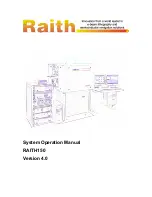
bend the lead firstly near the body of the device at an angle of 45 degrees. Then where the
metal leg thins, I bend it again so that it becomes parallel to the other two. The device should
then fit snugly into place on the board.
Whenever you need to bend legs of any semiconductor device be gentle. Its a good idea to
earth yourself too. Touching a nearby radiator or oscilloscope earthing tag is usually enough.
IC sockets are to be recommended, especially if this is your first electronics project. Make
sure, if you need to wash your board, that you get water in and around these sockets.
I would make the board in the following order: resistors, diodes, IC sockets, small non-polar
capacitors, transistors, electrolytic capacitors. Then the final water wash. Do not fit the pots,
trimmers, front panel LEDs or switches at this stage. The mounting of the pots, front panel
LEDs and switches requires special attention. See the next section for more details.
Mounting the Pots, LEDs and Switches
If you are using the recommended Eco pots, then they can support the PCB with specially
manufactured pot brackets. You will not normally need any further support for the board.
When constructing the board, fit the pot brackets to the pots by the nuts and washers supplied
with the pots. Now fit them into the appropriate holes in the PCB. But only solder the three
pins that connect to the pot.
Do not
solder the pot bracket at this stage. When you have
soldered all the pots you can fit the board to your front panel. Position the PCB at right angles
to the panel, the pot’s own pins will hold it fairly rigid for now. Then you can solder each of
the brackets. This will give you a very strong support and not stress the pot connections.
The Omeg pots are labelled A, B or C. For example: 47KA or 100KB. Omeg uses the
European convention of A = Linear, B = logarithmic and C = Reverse logarithmic. So a 1MB
is a 1 megohm log pot.
The four front panel mounted LEDs must be fitted carefully if you are using the directly
mounted technique in conjunction with the Schaeffer panel design. Although this sounds
fiddly, its actually quite easy and it reduces wiring, interference and possible errors.
Remove the front panel so that you just have the board again. Get the four LEDs and find the
cathode for each one. Make sure the cathode of the LEDs will go into the round pad, pin 2, on
the board. Carefully bend the LED’s legs at a point 6mm away from the plastic body of the
LED. The legs should be bent by 90 degrees so that the legs are pointing straight down.
Check to see if they fit into the board. The bottom of the LED’s body should fit just flush to
the board edge. Fit all four LEDs to the board but do not solder them in at this stage. Let their
legs poke through, there’s no need to cut them down yet. Now fit the front panel again to the
board and tighten the pot nuts. You should find that the board now fits snugly into position
and each LED should be just poking out of its hole neatly, albeit loosely. Align the LEDs if
they aren’t quite straight and solder each one in turn, trimming its leads nice and short
afterwards.
17
Summary of Contents for 3031 SuperBassLine
Page 24: ......








































